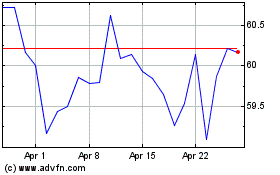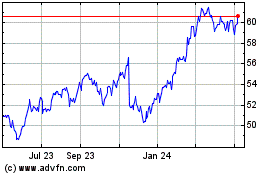Pandemic puts 10% of workforce on leave, prompts retailer to
require masks on staff
By Sarah Nassauer
This article is being republished as part of our daily
reproduction of WSJ.com articles that also appeared in the U.S.
print edition of The Wall Street Journal (April 20, 2020).
A picture hangs in the office of Walmart Inc. Chief Executive
Doug McMillon showing company trucks rolling into New Orleans after
Hurricane Katrina, an indication of the retailer's pride in quickly
restocking stores during the toughest of times.
Walmart is being tested like never before by a coronavirus
pandemic that has shut down much of the nation, put 10% of its
workforce on leave and led to at least 18 deaths at the company.
Managing the health of workers and shoppers, reassuring local
officials, and keeping stores and warehouses staffed have become a
massive effort inside Walmart at a time when customers are relying
more than ever on the nation's largest retailer.
"We are one of the few places in the country where a sizable
amount of people are gathering," said Dan Bartlett, a former Bush
White House official who is now a senior Walmart executive. The
company has been in communication with "just about every mayor and
governor you can think of."
The challenges are magnified at Walmart, the country's largest
employer with 1.5 million U.S. workers and more than $500 billion
in global sales. Walmart executives have debated various issues,
such as whether to give masks and gloves to workers, when to close
and clean stores, how to control shoppers who get too close to
workers and each other, and even whether to disable the
theft-detection systems connected to self-checkout machines,
according to people familiar with the discussions.
Starting next week, Walmart plans to require all workers to wear
masks, a spokesman told The Wall Street Journal, in line with a new
wave of local laws and in anticipation of new standards as
businesses open up as the virus wanes.
Worker absences have risen because of illness, fear of
coronavirus and as Walmart added more aggressive health checks and
generous leave policies, according to interviews with executives
and store workers. Around 150,000 people are on leave, said a
person familiar with the situation, and fewer than 2,000 workers
have tested positive for Covid-19.
"The health of our associates tends to track the health of the
country as a whole," the company said. "We are following the
evolving guidance of public health experts, and we have quickly
taken steps aimed at keeping our customers and associates
safe."
People are turning to the retailer more than ever, for
necessities or a job. Sales at Walmart's 4,700 U.S. stores surged
nearly 20% in March, according to documents reviewed by the
Journal. More than one million people applied to work at the
company in the past month. It hired 150,000 of them, and plans to
hire another 50,000.
Walmart started ramping up hiring in mid-March as sales for food
and cleaning supplies surged. A 12-person team built a system to
onboard new workers within 24 hours, instead of the usual two
weeks, said Drew Holler, a senior vice president. The goal: Hire
5,000 people a day.
Many new hires have come from the hospitality and food-service
industries, Mr. Holler said.
Don Monagan, a 26-year-old who lives in Niagara Falls, N.Y., was
running the kitchen in a family-owned restaurant when the state
forced all nonessential businesses to shut. Now working in a
Walmart deli, he makes $16 an hour, more than he earned in his
former salaried position.
"Most of us are just glad that it's busy, and we have somewhere
to work, " Mr. Monagan said.
At first, Walmart executives discussed closing some U.S. stores
so they could keep shelves stocked and have enough people to run
them. Instead they chose to close stores overnight for cleaning and
stocking. The executives decided to hire additional workers and
give cash bonuses to existing staff. The company hasn't raised its
minimum starting wage, $11 an hour.
James Sexton, the mayor of Evergreen Park, Ill., temporarily
revoked his local Walmart's liquor license earlier this month after
two workers died of Covid-19. The store manager wouldn't share much
about the status of sick workers in late March, Mr. Sexton said, so
he was surprised when Walmart said in April that two had died.
After Mr. Sexton pulled Walmart's liquor license "my phone rang
and it was an attorney," who set up a Saturday morning call with
two Walmart executives, the mayor said. He reinstated the license
after the Walmart executives assured him the store had been
sanitized twice, the deceased workers hadn't been in the building
for more than a week, and they apologized for not telling the
city.
"We have lost some associates, and that is obviously painful,"
Mr. McMillon said April 9 in a memo to all staff. "The numbers
we've seen so far don't indicate a disproportionate impact, but we
must stay vigilant, " he said, adding that Walmart has temporarily
closed an e-commerce warehouse and a few stores.
Walmart's history of keeping stores stocked amid natural
disasters is helping, but "nobody had the answers on the front side
of this," said Rollin Ford, a former Walmart executive responsible
for logistics involved in the company's Katrina response and other
disaster recovery efforts. "We did for a hurricane. We did for some
kind of geographic issue, but we didn't have something prescribed
for a national issue like this."
Walmart has the benefit of recent pandemic experience in China,
where it has more than 400 stores, 16 of them in Wuhan, the Chinese
coronavirus epicenter. Throughout a two-month lockdown, the company
briefly closed only two, as the government cleared the way for
deliveries and Walmart worked to locate new local sources of
food.
But unlike China, where the national government has total
control, in the U.S., Walmart must navigate state and county
regulations. Vermont, Michigan and other local governments have
told retailers not to sell items deemed nonessential, including
craft supplies, toys and furniture. Some restrictions have caused
confusion and pushback from shoppers. In Vermont, Walmart can't
sell clothes. In Pennsylvania, it can.
Walmart is making adjustments to safety policies amid mounting
illness, local government requests and changing CDC guidelines.
They include adding plexiglass barriers to pharmacy areas and
checkout lines. It started limiting how many people can enter its
stores to 20% of their capacity. It has temporarily closed stores
for deeper cleaning in some virus hot spots, like New Orleans.
At the start of each shift, workers are asked health questions
and have temperatures checked. Those with fevers or symptoms are
sent home with sick pay and cannot return for seven days or until
they are fever free for at least three. A Walmart worker in western
Pennsylvania said three of roughly 30 staffers were sent home
because of suspected illness during a recent shift.
"We will continue to be proactive in our approach to keeping our
associates safe," Walmart said.
Corporate employees in Bentonville, Ark., and elsewhere, started
working from home after March 13. Mr. McMillon and other top
executives are frequently visiting stores and warehouses, posting
pictures on Instagram. In recent days, Mr. McMillon wears a mask in
his photos. The company has opened nine of the drive-through
Covid-19 testing sites that Mr. McMillon discussed in a White House
press conference a month ago. Twenty are planned by the end of
April, a spokeswoman said.
Walmart has adjusted the flow of products to warehouses and
stores to meet the surge in demand for food and household goods,
prioritizing space on delivery trucks for those items. The system
is still strained enough that Walmart is asking shoppers to buy
less.
"In the last five days, we have sold enough toilet paper for
every American to have their own roll," Mr. McMillon said earlier
this month on the "Today" show. If people could "buy week-to-week
rather than stocking up," he said, "it would be helpful to
everybody."
Write to Sarah Nassauer at sarah.nassauer@wsj.com
(END) Dow Jones Newswires
April 20, 2020 02:47 ET (06:47 GMT)
Copyright (c) 2020 Dow Jones & Company, Inc.
Walmart (NYSE:WMT)
Historical Stock Chart
From Jun 2024 to Jul 2024

Walmart (NYSE:WMT)
Historical Stock Chart
From Jul 2023 to Jul 2024
